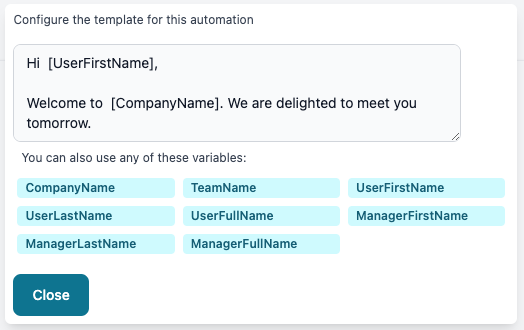Unlocking Efficiency: A Deep Dive into User-Defined Automations
In the fast-paced world of HR management, efficiency is the key to success. That's why our latest feature, User-Defined Automations, is a game-changer. It puts the power in your hands, allowing you to control the flow of data exactly as you need it.
Efficiency through Automation:
Automation revolutionizes HR operations by eliminating time-consuming manual tasks and reducing the risk of human error. With our automation engine, HR professionals can automate routine processes and focus on strategic initiatives that drive employee engagement and organizational growth. By streamlining workflows, automating approvals, and triggering actions based on predefined events, HR teams can achieve greater efficiency and productivity.
Understanding User-Defined Automations
What Are User-Defined Automations?
User-Defined Automations are a set of tools designed to empower you, the user, with the ability to customize the flow of data within our HR application. This means that you can dictate specific actions based on internal events, all with a user-friendly template.
We understand that simplicity is crucial when it comes to configuring automation recipes. Our automation engine boasts a user-friendly interface, guiding users through the process step-by-step. By utilizing a logical sentence structure, HR professionals can easily define the trigger events, specify timing, select actions, and determine the target audience for each automation. This intuitive interface ensures that even those without extensive technical expertise can harness the power of automation effortlessly.
Driving Timely Actions and Reminders:
One of the key benefits of automation is the ability to trigger actions instantly, or schedule them to occur before or after specific events. This ensures that HR processes are carried out in a timely manner. For example, managers can receive immediate notifications when a time-off request is submitted for approval, reducing delays and enhancing efficiency. Additionally, reminders can be scheduled to alert employees or managers about upcoming events such as birthdays, work anniversaries, or important deadlines. These timely actions and reminders help keep HR processes on track and improve overall organizational productivity.
Reducing Administrative Burden:
Automation significantly reduces the administrative burden on HR professionals. By automating repetitive tasks, such as sending notifications, generating reports, or updating employee records, HR teams can save valuable time and resources. This allows HR professionals to focus on more strategic initiatives, such as talent development, employee engagement, and organizational culture.
Ensuring Consistency and Compliance:
Automation helps enforce consistent processes and ensures compliance with HR policies and regulations. By automating workflows, organizations can standardize procedures and minimize the risk of manual errors or oversights. This not only improves operational efficiency but also reduces compliance-related risks, ensuring that HR practices align with legal requirements and industry standards.
How Does It Work?

Each button from this phrase will open a context menu with available options. For example, clicking on the "When" button will open a context menu with available options for the trigger time.
Let's break down the phrase template:
"When" the "event" happens, then "action" is performed for "user". Use this "template".
- When: This is the trigger time. It can be the time of the event or hours (days) before or after that event. Some restrictions apply.
- event: This is the trigger event. It could be an event like onboarding, offboarding, a time-off request, or even a birthday celebration.
- then: A simple connector.
- action: This is what happens when the event occurs. You decide – send an email, create a notification, or any other predefined action.
- is performed for: Another connector.
- user: This is where you specify who the action is performed for. It could be an individual user, their manager, their team, or any other relevant option.
- Use this: another connector
- template: allows you to customize the template to be used when sending email or notification


But here's the beauty: we've also thrown in variables. Variables like CompanyName, FirstName, LastName, and TeamName. These aren't just placeholders; they dynamically change based on the context. So, if you're sending an email, it can be personalized to say "Hello[FirstName]" or "Dear[TeamName]."

Why User-Defined Automations Matter
- Tailored to Your Processes: Every company is unique. With User-Defined Automations, you're not adapting to a system; the system adapts to you. Define your processes, and let the automation follow suit.
- No Coding Required: Forget about needing a coding degree. Our user-friendly template lets you create powerful automations with a few clicks. No tech headaches, just streamlined efficiency.
- Real-Time Control: Need to adjust an automation on the fly? With a few clicks, you're in control. No waiting for IT support or navigating through complex settings.
- Data Accuracy: By controlling the flow of data, you reduce the risk of errors. Ensure that the right information reaches the right people at the right time.

Conclusion:
Automation is transforming HR operations by streamlining processes, enhancing efficiency, and personalizing the employee experience. Our HR application's automation engine empowers HR professionals to automate repetitive tasks, trigger timely actions, and deliver personalized communications. By harnessing the power of automation, HR teams can drive productivity, reduce administrative burdens, and create a seamless employee experience. Embrace automation in your HR practices and unlock the full potential of your HR department.
Stay tuned for more exciting updates and insights on our product blog!